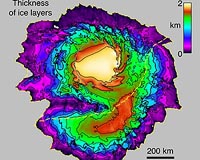 |
College Station TX (SPX) Nov 05, 2009 Is there such a thing as "weather" on Mars? There are some doubts, considering the planet's atmosphere is only 1 percent as dense as that of the Earth. Mars, however, definitely has clouds, drastically low temperatures and out-of-this-world dust storms, and Istvan Szunyogh, a Texas A and M professor of atmospheric sciences, has been awarded a NASA grant to analyze and forecast Martian weather. Mars is the most Earth-like planet we know, but it is still quite different. For example, it is much colder on Mars. The south pole of the Earth is covered by water ice, but the south pole of Mars wears a dry ice (frozen carbon dioxide) cap. In winter, the temperature at the poles can dip to -140 degrees C (-220 degrees Fahrenheit), which is so cold that even carbon dioxide freezes. "Planet-encircling Martian dust storms, which occur every two to four Mars years, can cover the whole planet with dust for months," notes Szunyogh, who is working with colleagues from the University of Maryland and the Geophysical Fluid Dynamics Laboratory in Princeton, N.J., to forecast Martian weather. Why care about weather on Mars? After all, nobody lives, works or goes to school there. "Martian weather forecasts, in the short term, can drastically increase the safety of landing robotic exploration missions," comments colleague Mark Lemmon, a Texas A and M professor of atmospheric sciences who has led or participated in many Mars exploratory events. "In the long run, it is indispensible for the safe returning of astronauts in future manned explorations. "The two rovers currently working on Mars are solar-powered, and their lives end when their batteries run out," Lemmon adds. "Dust storms block the sun and shorten their battery life, and winds, on the other hand, can clear their solar panels so their batteries recharge faster." Weather forecasting is not tossing dice. It must build on solid data. "All weather forecasts, including those on TV, are based on model forecasts of the different physical parameters of the Earth's atmosphere such as temperature, wind and pressure," Szunyogh says. "The main goal of our project is to explore the possibility of obtaining accurate quantitative estimates of these parameters of the Martian atmosphere. "These parameters will be obtained from the available remotely sensed Martian observations," he adds. "Then the data can be fed into Mars global circulation models, producing Martian weather forecasts like what we have for Earth." Share This Article With Planet Earth
Related Links Texas A and M University Mars News and Information at MarsDaily.com Lunar Dreams and more
 Radar Map Of Buried Mars Layers Matches Climate Cycles
Radar Map Of Buried Mars Layers Matches Climate CyclesPasadena CA (SPX) Sep 25, 2009 New, three-dimensional imaging of Martian north-polar ice layers by a radar instrument on NASA's Mars Reconnaissance Orbiter is consistent with theoretical models of Martian climate swings during the past few million years. Alignment of the layering patterns with the modeled climate cycles provides insight about how the layers accumulated. These ice-rich, layered deposits cover an area one ... read more |
|
| The content herein, unless otherwise known to be public domain, are Copyright 1995-2009 - SpaceDaily. AFP and UPI Wire Stories are copyright Agence France-Presse and United Press International. ESA Portal Reports are copyright European Space Agency. All NASA sourced material is public domain. Additional copyrights may apply in whole or part to other bona fide parties. Advertising does not imply endorsement,agreement or approval of any opinions, statements or information provided by SpaceDaily on any Web page published or hosted by SpaceDaily. Privacy Statement |